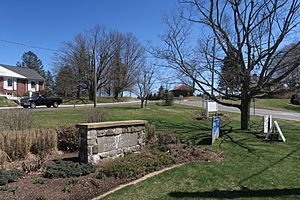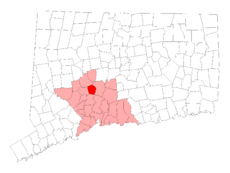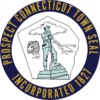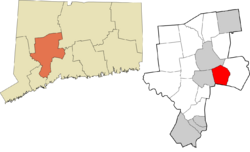Prospect, Connecticut facts for kids
Quick facts for kids
Prospect, Connecticut
|
|||
|---|---|---|---|
| Town of Prospect | |||

Welcome to Prospect
|
|||
|
|||
 New Haven County and Connecticut New Haven County and Connecticut |
|||
| Country | |||
| U.S. state | |||
| County | New Haven | ||
| Region | Naugatuck Valley | ||
| Settled | 1710s | ||
| Incorporated | 1827 | ||
| Government | |||
| • Type | Mayor-council | ||
| Area | |||
| • Total | 14.5 sq mi (37.6 km2) | ||
| • Land | 14.3 sq mi (37.1 km2) | ||
| • Water | 0.2 sq mi (0.6 km2) | ||
| Elevation | 823 ft (251 m) | ||
| Population
(2020)
|
|||
| • Total | 9,401 | ||
| • Density | 648.3/sq mi (250.0/km2) | ||
| Time zone | UTC-5 (Eastern) | ||
| • Summer (DST) | UTC-4 (Eastern) | ||
| ZIP code |
06712
|
||
| Area code(s) | 203/475 | ||
| FIPS code | 09-62290 | ||
| GNIS feature ID | 0213493 | ||
Prospect is a town in Connecticut, United States. It's located in the Naugatuck Valley Planning Region. Prospect is like a neighborhood for the city of Waterbury, which is just north of it. It's also on the edge of the larger New York metropolitan area. In 2020, about 9,401 people lived there.
Prospect became an official town in 1827. Before that, it was part of Waterbury and Cheshire. Many people who live in Prospect travel to other cities for work. Prospect is also part of a local health district called Chesprocott, along with the towns of Cheshire and Wolcott.
Contents
History of Prospect
Early Days and Native Americans
People believe that Native Americans lived in the Prospect area a very long time ago, possibly between 20,000 and 40,000 years ago. We don't know much about their daily lives here. Only a few tools like arrowheads have been found.
The area was a hunting and fishing spot for the Quinnipiac and Tunxis tribes. There's no proof that Native Americans lived here permanently before European settlers arrived. A small Native American reservation was set up in the Waterbury part of town from 1731 to 1778. It was about 50 acres (20 hectares) and had only four people living there in 1774.
European Settlement and Town Name
The first record of land ownership in Prospect dates back to 1694. European settlers started building homes in the "West Rocks" area around 1712. This was near the border of Waterbury and Cheshire.
In 1775, citizens wanted their own church, but both towns said no. So, in 1778, a separate church was built. It was called the "Society of Columbia," which later became the Columbia church. In 1797, the area was known as Columbia Parish.
When it became an official town in 1827, they wanted to name it Columbia. But there was already a town called Columbia in Tolland County. So, they chose the name Prospect instead. This name was picked because of the amazing view from the town green. Before trees grew tall, you could see Long Island Sound, the Connecticut River, and even Long Island on clear days!
Farming and Factories
For a long time, farming was the most important part of Prospect's economy. People grew and made things like wood, charcoal, hay, apples, milk, cheese, and corn. It wasn't until the 1950s that other jobs became more common.
The town also had some factories, especially during the Industrial Revolution. Farmers often worked in factories to earn extra money. Factories that needed water power were built near the town's edges, where the land dropped steeply. This allowed them to get a lot of power from the water.
The Rag Hollow area, near Cheshire, had the most factories. They made things like sewing needles, metal dishes, cutlery, buttons, and wagon wheels. The very first parlor matches in the United States were made in Prospect by a factory called Ives & Judd. By the 1900s, most of these factories closed, and business owners moved to bigger cities.
Modern Changes and Growth
Because Prospect was a small, rural town, modern services came slowly. A telephone line passed through in 1898, but a phone wasn't installed in town until 1904. Electricity arrived in 1929. At first, only a few places like the church had power.
Most roads were dirt until the 1920s, when they became gravel. Besides two main state highways, other roads weren't paved until 1968. Prospect had a post office from 1830 to 1902, then it closed. A new one reopened in 1962.
Today, Prospect doesn't have public sewer service. Most homes and businesses use septic systems. Some roads have public water connections since 2002, but many still use wells for water.
Since the 1950s, Prospect has grown a lot as a suburban town. Many families moved here from nearby cities, especially after the "Black Friday Flood" in 1955. During that flood, Prospect became a safe place for people who lost their homes. They stayed in the Community School, which helped more people decide to move to the town. Today, most houses in Prospect are single-family homes built after 1950.
The "Best Small Town" Story
Prospect is known locally as "The Best Small Town in Connecticut." You can even see this phrase on town trucks and its website! This saying started in the early 1990s. A magazine called Connecticut ranked Prospect as the worst small town in the state. They looked at things like schools, economy, cost of living, crime, and cultural places.
In response, the town's long-time mayor, Robert Chatfield, removed the magazine from the library. He then declared Prospect "The Best Small Town in Connecticut." He even ordered the phrase to be put on town vehicles and bumper stickers!
Geography
Prospect covers a total area of about 14.5 square miles (37.6 square kilometers). Most of this is land, with only about 0.2 square miles (0.6 square kilometers) being water.
Prospect shares its borders with several other towns:
Population and People
| Historical population | |||
|---|---|---|---|
| Census | Pop. | %± | |
| 1830 | 651 | — | |
| 1840 | 548 | −15.8% | |
| 1850 | 666 | 21.5% | |
| 1860 | 574 | −13.8% | |
| 1870 | 551 | −4.0% | |
| 1880 | 492 | −10.7% | |
| 1890 | 445 | −9.6% | |
| 1900 | 562 | 26.3% | |
| 1910 | 539 | −4.1% | |
| 1920 | 266 | −50.6% | |
| 1930 | 531 | 99.6% | |
| 1940 | 1,006 | 89.5% | |
| 1950 | 1,896 | 88.5% | |
| 1960 | 4,367 | 130.3% | |
| 1970 | 6,543 | 49.8% | |
| 1980 | 6,807 | 4.0% | |
| 1990 | 7,775 | 14.2% | |
| 2000 | 8,707 | 12.0% | |
| 2010 | 9,405 | 8.0% | |
| 2020 | 9,401 | 0.0% | |
| U.S. Decennial Census | |||
In 2010, there were 9,405 people living in Prospect. Most people (95.3%) were White. About 1.9% were African American, and 0.8% were Asian. People of Hispanic or Latino background made up 3.3% of the population.
The average age in Prospect was 43.8 years. About 22.6% of the population was under 18 years old.
Education
Since 1969, Prospect and the town of Beacon Falls have worked together to run Regional School District 16. This district was created so that both towns could have their own high school.
Before Woodland Regional High School was built, Prospect students went to Wilby High School in Waterbury until 1983. After that, students could choose to attend high schools in nearby towns like Woodbury, Wolcott, or Naugatuck.
In 1998, people in the region voted to build Woodland Regional High School in Beacon Falls. It opened on September 4, 2001.
Today, Regional School District 16 runs four schools. The money for the schools comes from both towns, based on how many students from each town attend. In 2020, Prospect paid about $20.5 million because its students made up 63.25% of the district's population. This money comes from property taxes.
In 2011, voters approved a plan to build a new Prospect Elementary School. They also renovated Laurel Ledge Elementary School. The new Prospect Elementary School (for grades K-5) replaced two older schools. Students in grades 6-8 from both Prospect and Beacon Falls go to Long River Middle School. Students in grades 9-12 attend Woodland Regional High School.
Transportation
Prospect is well connected to Connecticut's road system. Route 69 and Route 68 cross near the town center. These roads help residents get to cities like New Haven, Waterbury, and Naugatuck.
Entrances to major highways like I-84 are close to the Waterbury-Prospect border. Entrances to I-691 are near the Cheshire-Prospect border.
There are no bus routes directly within Prospect. However, bus stops for the Greater Waterbury Bus System are located just north of the town line in Waterbury.
Notable People
- Robert Chatfield – A politician who served as mayor for a long time.
- John Fusco – A talented screenwriter and producer.
- Julius Hotchkiss – A politician from Prospect's past.
- Vincent Ingala – A smooth jazz and R&B saxophonist.
Images for kids
See also
 In Spanish: Prospect (Connecticut) para niños
In Spanish: Prospect (Connecticut) para niños






